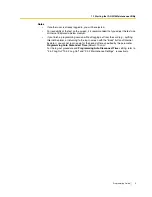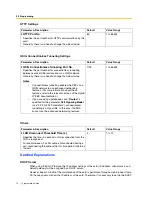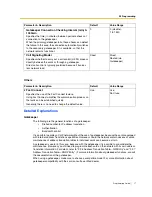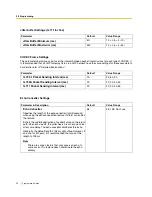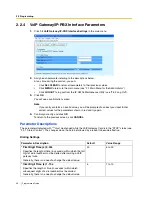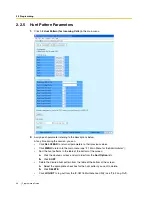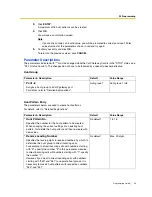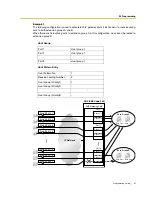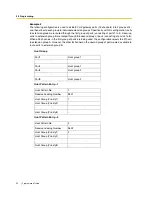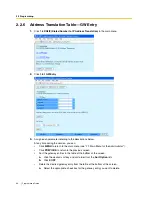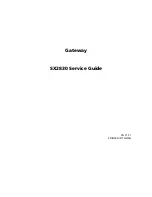
2.2 Programming
Programming Guide
19
You will see a confirmation screen.
Note
If your entry contains an invalid value, you will be prompted to correct your input. Enter
correct values for the parameters shown in red and try again.
4.
Confirm your entry and click
OK
.
To return to the previous screen, click
CANCEL
.
Parameter Descriptions
QoS Field Settings
The parameters below are used to set the ToS (Type of Service) field in the header of IP packets to control
QoS of VoIP communications.
For more information about QoS, refer to "A1.4 QoS (Quality of Service)" of the VoIP Gateway Card Getting
Started. For the actual setting values, consult your network administrator.
Jitter Buffer Settings
When voice signals are packetised and transmitted, individual packets can take different paths through the
network and arrive at the destination at varied timings. This is referred to as "jitter", and it can cause
degradation in speech quality. To compensate for jitter problems, the "jitter buffer" accumulates the packets
temporarily for processing.
The parameters below are used to adjust the size of the jitter buffer. However, in general, there is no need to
change the default values.
Jitter buffer Settings (G.711/G.729A/G.723.1 for Voice)
Parameter & Description
Default
Value Range
ToS
Specifies the value in the ToS field by a generic term.
For details, refer to "Detailed Explanations".
Priority: 0
0 to 7
Normal
Normal,
Monetary Cost,
Reliability,
Throughput,
Delay
DSCP
Specifies the value in the ToS field by a DSCP for DiffServ.
No default
0 to 63
HEX
Specifies the value in the ToS field by a hexadecimal number.
No default
00 to FF
Parameter
Default
Value Range
Jitter Buffer Minimum (ms)
20
10 × n (n = 2–10)
Jitter Buffer Maximum (ms)
500
10 × n (n = 2–50)
Jitter Buffer Default (ms)
20
10 × n (n = 2–10)
Jitter Buffer Recovery Start (ms)
200
10 × n (n = 2–10)
Jitter Buffer Recovery Period (s)
10
1 to 20
Summary of Contents for KX-TDA0490
Page 4: ...4 Getting Started ...
Page 20: ...2 2 Cable Connection 20 Getting Started ...
Page 45: ...Getting Started 45 Appendix A Guidance for VoIP Installation ...
Page 55: ...Getting Started 55 Appendix B Alternative Numbering Plan Example ...
Page 63: ...Getting Started 63 Appendix C Initialisation of the VoIP Gateway Card ...
Page 66: ...C1 Initialising the VoIP Gateway Card 66 Getting Started ...
Page 67: ...Getting Started 67 Appendix D Using the KX TDA0490 and KX TDA0480 in One Network ...
Page 69: ...D1 Considerations in Installation Getting Started 69 ...
Page 76: ...1 1 Starting the IP GW16 Maintenance Utility 6 Programming Guide ...
Page 126: ...2 5 Others 56 Programming Guide ...
Page 139: ...Programming Guide 69 Index ...

